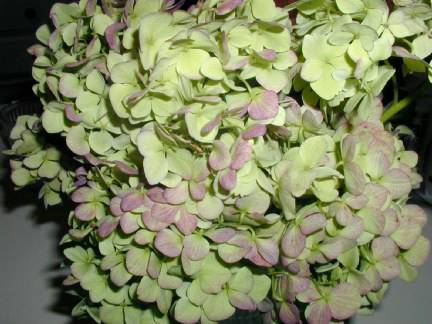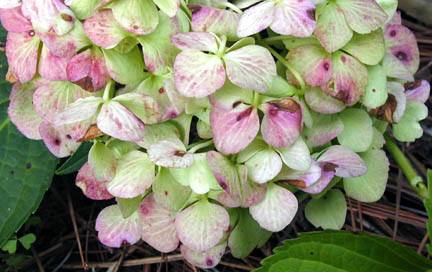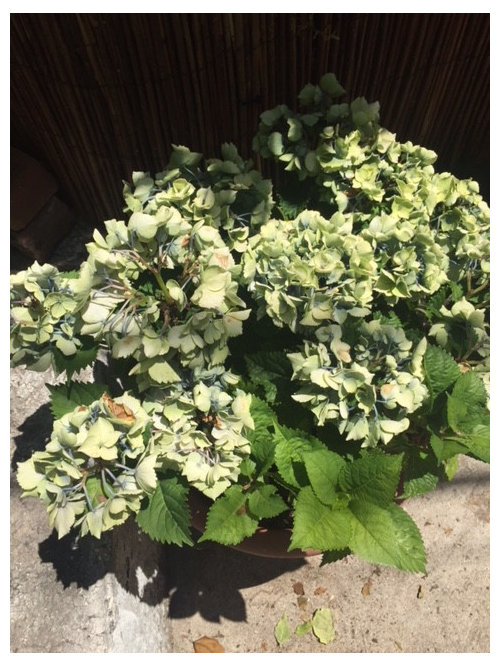
Because hydrangea blooms age throughout the year, their color gradually fades from vivid hues to light green. With fewer daylight hours, the hydrangea has less energy to develop the pigment that gives its blossoms their vibrant colors, which causes the petals to become green.
Read on to find out why hydrangea blooms turn green and whether you can stop this from happening.
Table of Contents
Why Hydrangeas Flowers Turn Green
| Reason: | Greening Hydrangeas: |
| The Hydrangea Flower’s Life Cycle | Before the blooms turn brown, many distinct hydrangea kinds’ flowers turn green as the season progresses owing to aging and in reaction to seasonal change. |
| In response to shorter daylight hours: | The hydrangea loses vitality as the number of daylight hours decreases, and the floral pigments that give the hydrangea its vibrant hues begin to deteriorate, turning the blossoms green. |
| Humidity and Heat: | Hydrangea blossoms seem more likely to become green in warmer and more humid conditions. High humidity, which is at variance with their native environment, as well as heat or drought stress may also have a role. |
Life Cycle of the Flower- Hydrangea Flowers Turn Green as they Age

The fact that your flowers have gone green may not signal any issues or environmental stress, but rather that the concentration of color pigments in the leaves changes during the course of the Summer, resulting in the flowers turning green. This is a typical cycle of hydrangea flowers.
The hydrangea’s determinant is not its green blossoms.
In contrast to other plants, hydrangeas have blossoms that change color throughout the growing season rather than remaining a constant shade.
Since some hydrangea kinds turn green more quickly than others, the rate at which hydrangea flowers turn green varies from year to year.
If the blossom has gone green, the soil’s acidity and alkalinity or the presence of aluminum sulfate, which can alter color, are not to blame for the transformation.
However, it should be noted that if soil pH changes, some hydrangea species may experience a change in the color of their blossoms from blue (which indicates acidic soil) to pink (which indicates alkaline soil).
Day Length Contributes to Hydrangea Flowers Turning Green
When there are less sunshine hours, hydrangea flowers might turn green. There is less energy available for the flower heads to produce the blue, pink, or white coloration in the blooms as the number of hours of sunshine decreases. In the late Summer, this causes the hydrangea flowers to become green instead of their original color.
The shorter day lengths are assumed to be the cause of the flowers becoming green rather than the brightness of the light.
This explains why the hydrangea blooms most frequently turn green at the end of Summer when there are less daylight hours, whereas during the height of Spring when there are more daylight hours, the plant has the energy to generate the more colorful pigments in the flowers.
But I would stress that you must not use this as a recommendation to place your hydrangea in more direct sunlight.
The majority of hydrangea species do not handle full sun as it will burn the leaves and flowers, so always plant your hydrangeas in dappled light or early sun followed by afternoon shade. Hydrangeas are woodland plants that typically grow under a tree canopy.
Heat and Humidity- Green Hydrangea Flowers
Heat and humidity are believed to be additional factors in the greening of hydrangea flowers. Although it seems that hot, humid locations are more likely to have hydrangeas that turn green, the precise cause of this is unclear.
Because they are thirsty plants, hydrangeas need moist soil all the time to keep their leaves and petals from drooping.
The hydrangea may be in stress if the temperature is high because the root system cannot replenish moisture lost by the leaves quickly enough.
The hydrangea blossoms’ transformation from their natural hue to a pale green or even brown is thought to be accelerated by this kind of stress paired with the humidity.
The fact that hydrangeas can endure some heat and humidity is somewhat at odds with their native woodland habitat, thus this may be a reflection of conditions that are different from those to which they are suited.
(Read my post on how to save a hydrangea from wilting.)
How to Stop Hydrangeas Turning Green

Even with the greatest maintenance techniques, hydrangea blooms can still turn green as they age or in response to fewer hours of light, which results in a decreased concentration of the color pigments in the flowers, at the end of the season.
Despite the fact that the precise reason why hydrangeas turn green is frequently unknown, these plants can still flourish even if their flowers turn green.
For unknown reasons, hydrangeas can occasionally even turn green for a year or two before returning to their normal color.
(Read my article to learn why my hydrangea is browning.)
Some Hydrangea Varieties Naturally Have Green Flowers
Of course, there are hydrangeas with naturally occurring green blossoms, such as Hydrangea paniculata “Limelight,” which have a very classy appearance. Since this particular kind maintains its lime green hue throughout the growing season, green is one of the colors that hydrangea can use to display their flowers.
(Read my article to learn why my hydrangea isn’t in bloom.)
Key Takeaways:
- Because the color fades at the conclusion of the growth season, hydrangea blossoms turn green. Because the hydrangea requires less energy to create the pigments that give its flowers their blue, white, and pink hues, its blooms become green as the number of daylight hours decreases.
- Heat and humidity are incompatible with the hydrangeas’ native habitat and are regarded to be a factor in the flowers’ alleged greening.
- Some hydrangeas, including Hydrangea paniculata ‘Limelight,’ have naturally green blossoms that remain green all year long.
- The typical occurrence of hydrangea flowers turning green does not indicate that there is a problem with the hydrangea. At the end of the flowering season, the blossoms typically start to wilt and turn green before turning brown.
